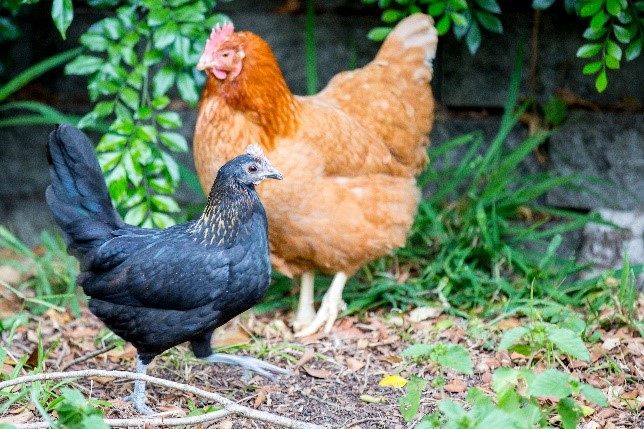
Although chickens are very social animals, the structure of their flock is based on their ability to communicate, a dominance hierarchy known as their ‘pecking order’ (in fact, it’s where the term ‘pecking order’ comes from!), and their ability to recognise other members of their flock. In these flocks, hens and chicks are the core, with roosters living almost independently.
Communication
Chickens use a variety of communication modes. They maintain their personal space using postural changes, with the position of the head and the relative angles of the head and the body to other bird, the position of their wings and their tail, all giving important signals to their flock mates.
Further apart, they maintain contact by sight (up to intermediate distances), and by vocal communication (at longer distances or if out of sight). Vocal signals include food calls, predator alarm calls, pre- and post-laying calls, and rooster crowing. The clucking calls of the broody hen to her brood will result in all the chicks gathering close to her.
Communication therefore plays an important part in the maintenance of individual personal space, and flock organisation and integrity in a group situation.
The pecking order
Pecking is used to establish a hierarchical organisation or ranking structure in the flock of dominant and progressively subordinate members. This organisation is established separately for males and females in the same flock. Called the pecking order, the organisation commences at an early age and, depending on flock size and complexity, will be established by 10 to 16 weeks. This process follows a well-recognised sequence:
- Newly hatched chicks (1-3 days) have a strong imprinting or bonding period when the newly hatched chicken bonds onto the broody hen.
- This is followed fairly quickly by the development of escape behaviour – a protective mechanism.
- Shortly after, the first signs of aggressive behaviour are seen. Two chicks approach each other aggressively and then, before contact is made, they race away i.e., escape.
- This stage is followed by a period of play fights where they spar but do not make real contact.
- The final stage is where real contact is made and is the truly aggressive stage. It is from these true fights that the dominant/subordinate relationships are established. Submission is usually demonstrated by escape or crouching. The age that this is completed depends on the size and complexity of the flock but in most cases would be sometime after 10 weeks of age.
A separate pecking order is established for males and females in mixed-sex flocks.
Once established, the birds live in a harmonious state with no obvious dominant/subordinate relationship until the flock structure is altered, most commonly with the introduction of a new bird to the flock. A new chicken is lower in rank than any other member of the flock until they have found their place in the pecking order (this also applies when a bird is reintroduced to the flock after a long absence). This introduction will often start a series of fights as the new chicken’s place in the flock is determined.
Identification
To develop a pecking order, birds must be able to recognise individuals in a flock. This ability allows them to identify and peck only those hens lower in the pecking order. It appears that laying hens can recognise around 30 individuals, perhaps based on the shape of the comb, wattles, and head. Plumage colour and intensity may also be important. Despite this ability to recognise each other, their memory doesn’t appear to last too long – members of a flock that are broken up appear to forget each other within 3 to 4 weeks.
Once the flock structure has been finalised, the dominant hen eats first, gets to pick where she wants to roost or lay eggs, and is allowed to take choice morsels from the lesser-ranked hens. In small, well-managed flocks with enough space, the hens are generally calm and orderly as they go about their daily business.
Applying this to your backyard flock
You must consider the various aspects of the social organisation of the flock to minimise the disturbance of established relationships at those times when egg laying could be affected. Some suggestions to help you do this include:
- Form your flock while they are young and have not yet started to lay.
- Provide plenty of space and resources – not just floor space, but also feeders and waterers, perches, and next boxes – all things that can trigger competition.
- Avoid moving single birds or even small groups of birds from one flock to another.
- If it is necessary to join two groups, do so by separating the pen into two with wire netting and housing the groups, one on each side for a few days. Provide food, water, perches, and next boxes for each group. After a few days, open the netting barrier a small amount of time to allow the two groups to mingle gradually. If the two groups are combined immediately, the conflict that will probably develop may result in a significant number being injured by pen mates.
- Run roosters together as a group before placing them in with the hens.
- Placing a rooster with a group of hens will help to reduce disputes between the hens but may produce some fertile eggs.
References
Jacob J (2023) Normal behaviors of chickens in small and backyard poultry flocks.
Marino L (2017) Thinking chickens: a review of cognition, emotion, and behavior in the domestic chicken. Anim Cogn 20:127–147
